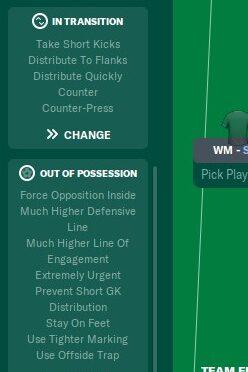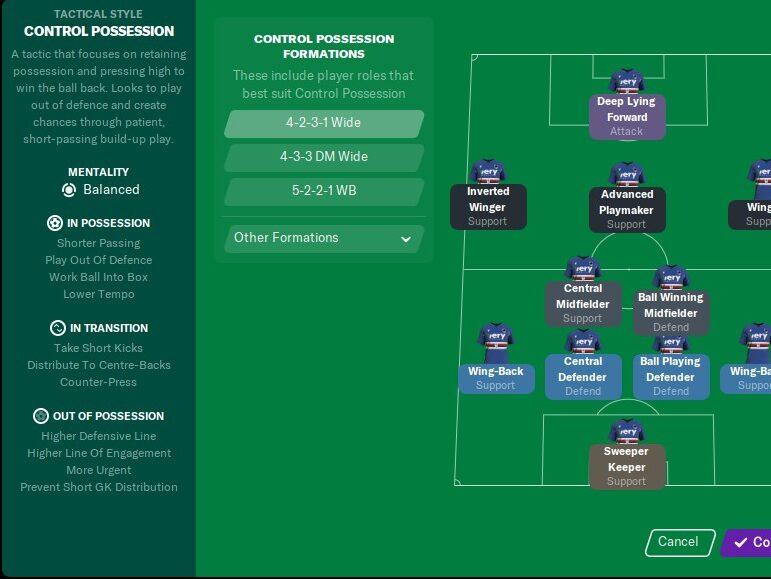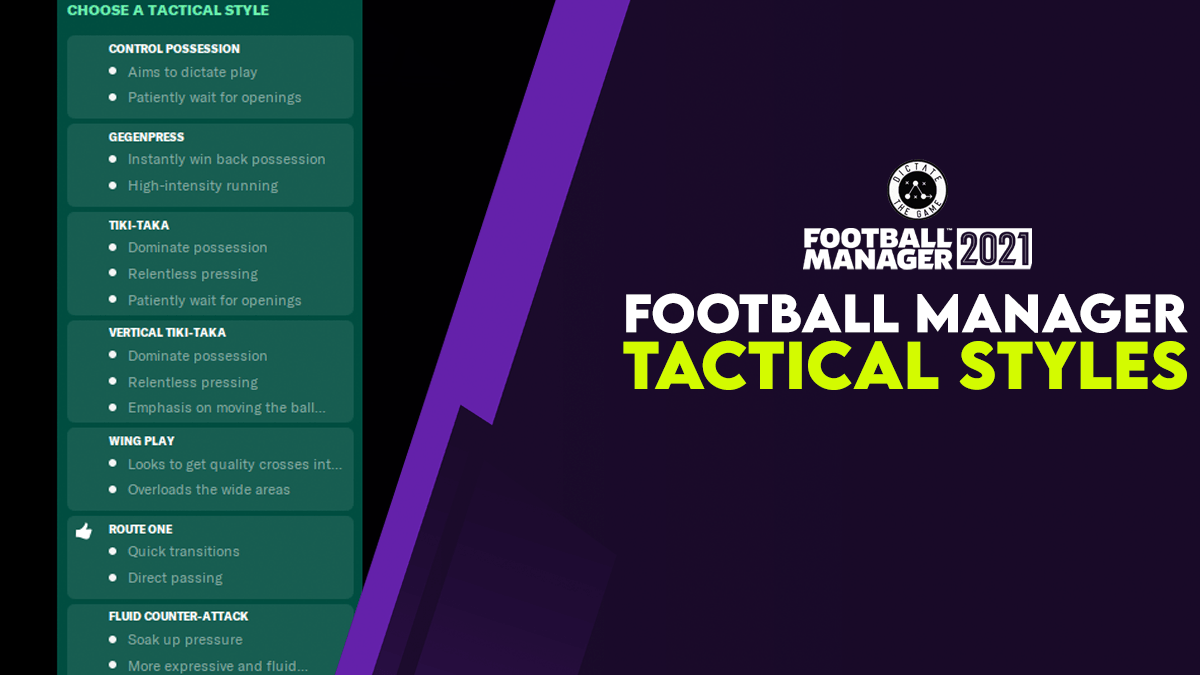
Football Manager Tactical Styles
Football Manager is renowned for giving its players a unique opportunity (among other things) to create tactics. Be that an experimental, never before seen inverted wingback diamond Christmas tree with 4 anchor men and 2 target men. Or a subtle tweak on everyone’s favourite Sunday league tactic; four, four, f**king two.
But what about the tactical styles provided by our beloved game?
Football Manager provides us with a selection of default tactical styles. In this piece, we’re going to have a look at how those default setups run, and more importantly, if they work. One of the most common pieces of advice for managers going through a rough spell is to strip back their tactic. Start from scratch, and assess what works for your team, and when.
If your team is going through a bad patch, conceding too many goals or not scoring enough, it can be hard to pinpoint where it’s all going wrong with overly complicated tactics. Before I’m inundated with critical comments, I don’t play this. It’s just an example I’ve created to emphasise what I’d call an ‘over tactic’.
Most Football Managers would use the clean slate option for creating a tactic; with all instruction, and mentality removed.
Lets have a look at the default tactical styles in Football Manager.
Control Possession
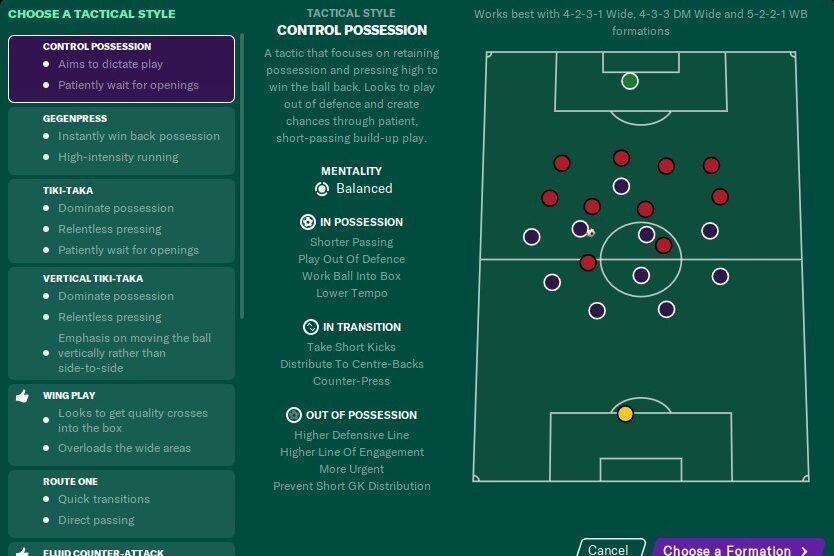
When creating a new tactic, you are presented with this rather handy guide on what to expect. From the bullet point breakdown of the principles of the tactic, the handy 2D moving illustration of how the tactic should work, and the team instructions that are used.
The next screen gives the Football Manager a list of suitable formations for the selected tactical style.
It is worth noting that a tactic and/or formation with a thumbs up denotes a tactical style that suits a club philosophy or a coach’s opinion of a tactic that suits the team.
The formation selection also automatically assigns player roles that are suitable for the tactic. For the purposes of this piece, I will select the top suggested formation, and leave player roles as defaults. I will also be using the tactic against the same opposition (Udinese) using Sampdoria in Italy’s Serie A.
Control Possession aims to dictate tempo and wait for openings. It comes in handy to have players who are composed, decisive, and good at passing.
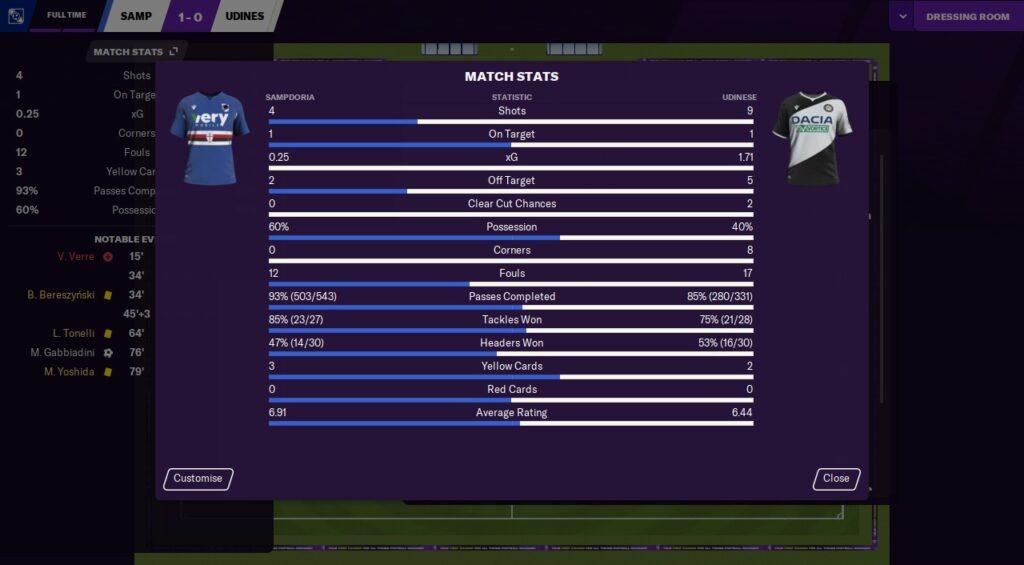
Control Possession gets us off to a winning start. A 1-0 victory in a match I had us down to lose. More impressively, and more pertinent to this article, we out possessed, and out passed them. Considerably too, I might add. Almost twice as many completed passes and 60% overall possession. The number of shots is slightly worrying, and the xG says we should have lost this game, but the overall principle of the tactic was to control possession. So on the whole, we have to concede, it works.
Gegenpress
Every Football Manager’s favourite tactical style. I think it’s safe to say this is the most widely used and tweaked tactic of them all. Ask Dom, in his latest article, I think he’d agree the majority of downloadable tactics are some slight alteration on a gegenpress. But how does the Football Manager default gegenpress fare on its own? We’re expecting more possession certainly, but we’re also expecting high outputs for distances and sprints. As well as a high line and high press, our heat map should be a lot higher up the pitch. A gegenpress needs physically fit, and mentally aware players. Stamina, natural fitness, concentration and teamwork should be high on your priorities.
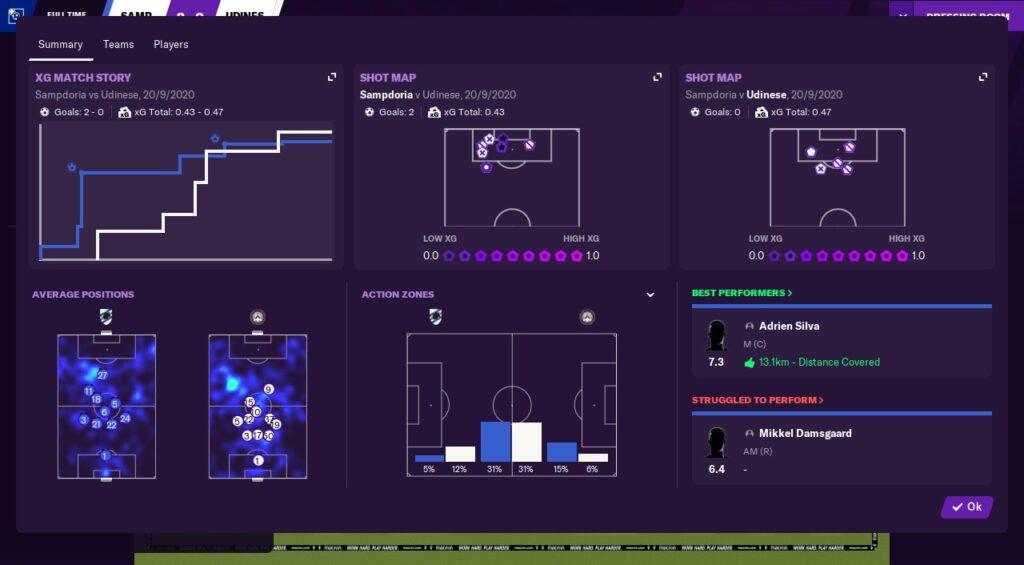
Another victory, 2-0 this time. The average positions show we played a higher line and forced the opposition deeper. The action zones are marginally in our favour, and we outran our opponents. The possession had only a 1% swing to us, and the xG was fairly similar. But the gegenpress did its job rather well. While the opposition had more possession than the control possession tactic, it was predominantly in their own half, and they were restricted in the amount of chances they could create.
Tika Taka
This Football Manager tactical style is fairly similar to the previous two, i like to consider it an amalgamation of the two. Aiming to control possession and win the ball back as quickly as possible. Tika taka utilises off the ball movement and physical fitness, attributes to look for in players.
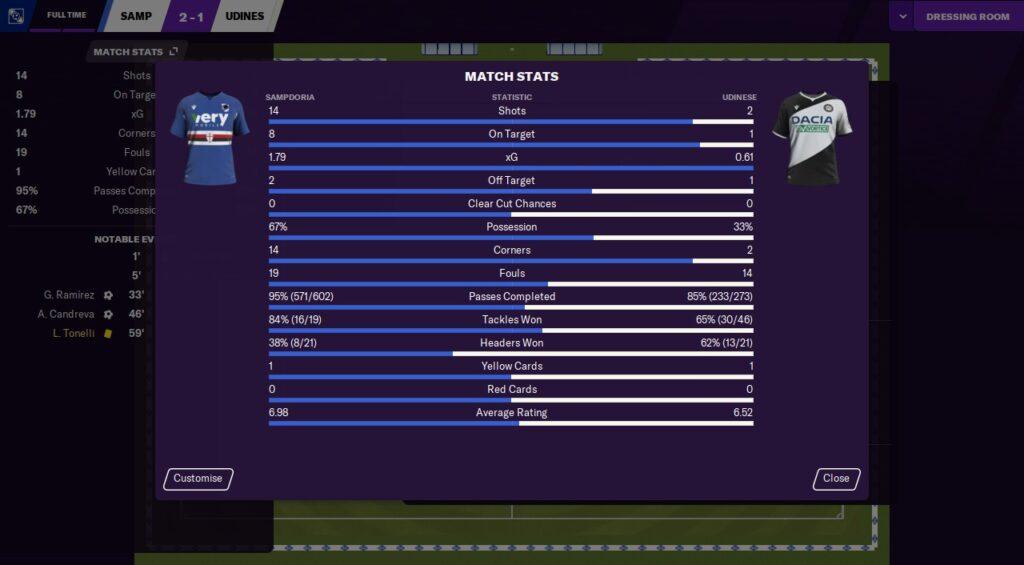
Well, I was not expecting that! Absolutely dominant. A 2-1 scoreline but a resounding dominance according to the stats. Out passed, out possessed, out run. The action zones reflect what was expected, with 36% of the action in the Udinese defensive third. They weren’t able to offer anything in the way of an attacking threat as they were simply pressed and then passed to death.
Vertical Tika Taka
As the description states, this tactical style is very similar to the Tika Taka, the difference being to utilise vertical lines of the pitch to pull defenders out of position. It still relies on a possession orientated play, and winning the ball back early.

Our first defeat. A 1-0 to what the commentary stated was a soft penalty. It seemed the tactic worked to an extent: we had marginally more possession, and our average position was higher up the field, this may have just been one of those games where things don’t go our way. Our xG was dismal, and number of passes equalled Udinese, which for a possession based tactic, is not good enough.
Wing Play
Overloads. That’s what we’re expecting to see in this tactical style. Wide overloads and plenty of crosses. This is a ‘thumbs up’ tactic for Sampdoria, a coach recommendation to fit the players we currently have at our disposal. As the ball is meant to be out wide more often than not, crossing and off the ball movements are key here, as well as a forward that can find space and finish those chances.

As expected, the focus of our attacks was down either flank. We had 15 crosses to their 4, but didn’t win enough of the aerial challenges to press home our advantage. We created more chances, and had more shots (on and off target) but weren’t able to take home the 3 points. A late De Paul penalty denying us a 1-0 victory.
Route One
Hoofball. Straight out the Tony Pulis handbook. Long, direct, defensive football. Big target man, little poacher. I’ve no idea what to expect from this, less possession, a lot of long forward passing, and not a lot else.
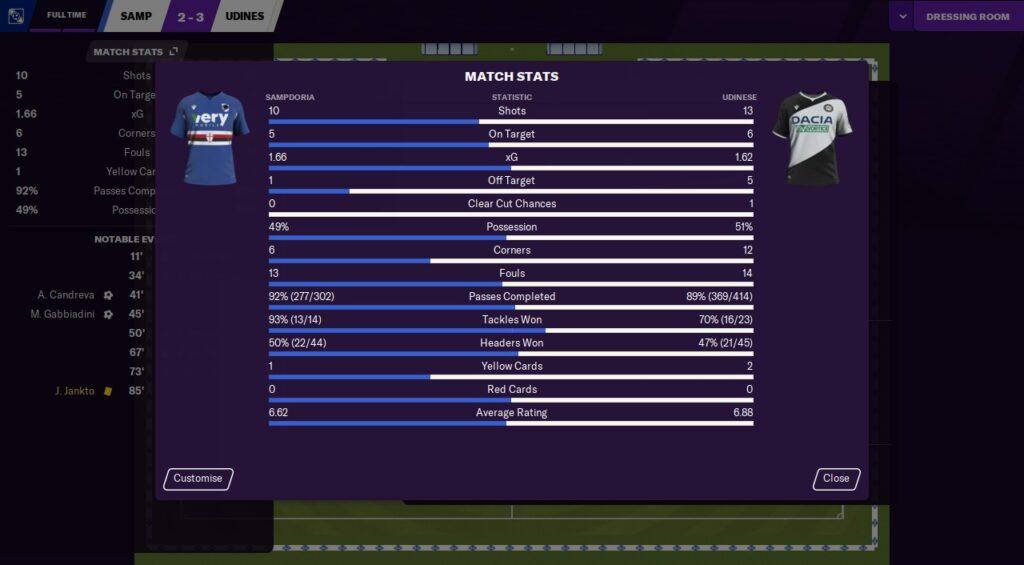
As unpredictable as the tactic. Shots galore, from both sides, possessions ebbing and flowing throughout the game, xG similarly balanced. One thing worth noting is that I was 2 down in the first half, pulling it back just before the interval. What can I say, employ this tactic for some good old fashioned League 2 football.
Fluid/Direct Counter Attack
The fluid and direct counter attacks are both set around the premise of conceding you are the lesser team. You expect to lose the battle for possession, and so aim to draw opponents onto a structured defence, before hitting on a counter attack. These Football Manager tactical styles vary on the attacking phase. While direct aims to get the ball forward as quick as possible, fluid uses shorter passing to open up space for players to exploit.
For the fluid counter attack, I was surprised to see 55% of the ball, and more shots, but lose the match 1-0. Despite playing to lure the opponent onto me, I seemed to play higher up the pitch and control the game.
The direct counter attack gave me a 1-0 victory, but like the fluid, I controlled the game more than I was expecting to.
Catenaccio
The “door bolt” system. In principle this tactical style comes across as a very defensive system, I however, think there is way more to it than simply nullifying the opposition threat. The early conception of this tactic employed a sweeper, who pushed ahead of the defence and stepped into midfield when in possession. Franz Beckenbauer being the most note worthy in this position, I’d hardly describe his team as trying to “nullify”.
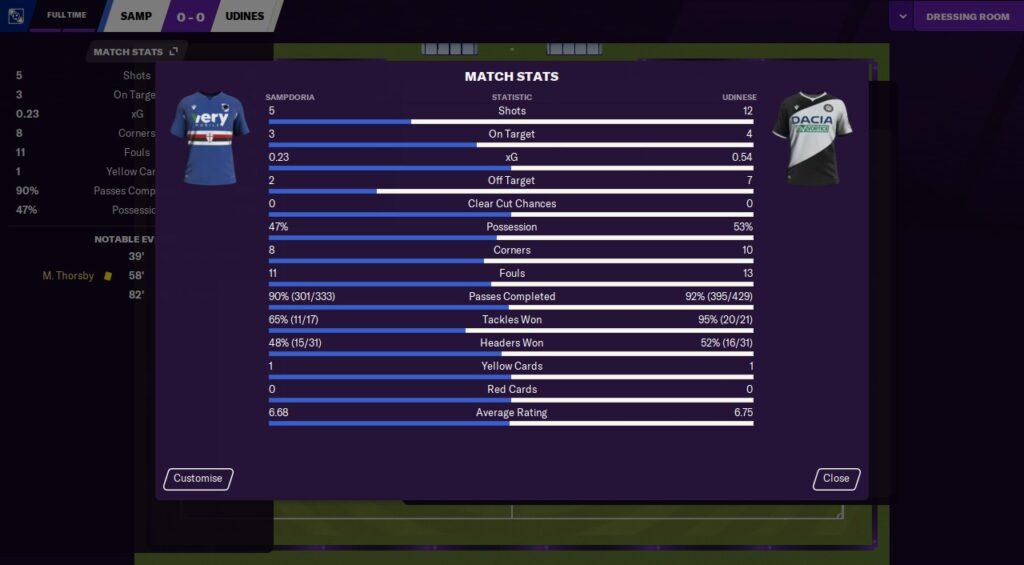
It finished 0-0, with us creating very little. A slightly misleading stat is the Udinese shots, they had 12 but they were from range and never likely to cause us problems. The catenaccio tactical style in Football Manager is designed to limit the oppositions attacking threat, and with an xG of 0.54, I’d say it met this criteria. With a little tinkering and tweaking of the in possession instructions, I think a catenaccio could be a very effective tactic.
Park the Bus
Anti football. For the teams expecting a whooping. Big Sam at West Brom. Waste time, break up play, don’t attack, defend for your life and go into every game chasing a 0-0 draw. If I score in this game I’ll be extremely upset.
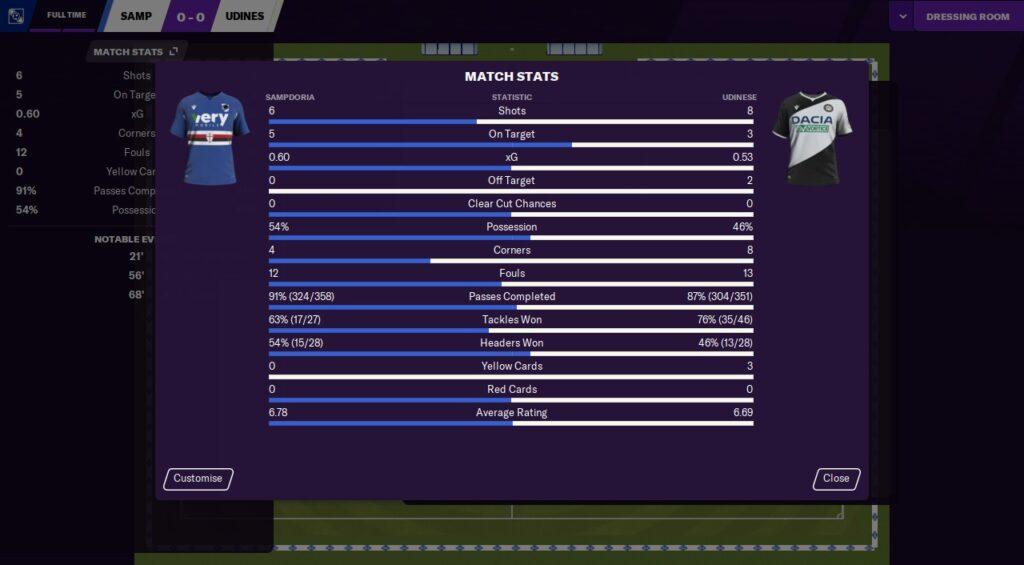
A surprisingly open game, and far more shots at my goalkeeper than I would like. But harmony is created with a 0-0. Both xGs are low, as I would have expected. Big Sam would be proud.
Summary
Default tactical styles in football manager vary massively. And they all can serve a purpose. From simplifying an overly complicated tactic, to playing a specific opponent. Each one serves its purpose well, and match stats and analytics back up the tactical instructions of each. I would be confident in using one of these tactics as a starting point for a new team, based on strengths and weaknesses. Then tweak certain aspects of it to suit me more, basing them on the team reports and team analysis. A lower league team for instance, may be extremely effective with the defensive setup of a catenaccio, and the quick and deadly force of a fluid counter attack.
Try them out, let us know how you get on by leaving a comment below.
Here’s a few more articles you may enjoy:
FM21 Training Features
EFL Championship guide
Deal with FM frustration
